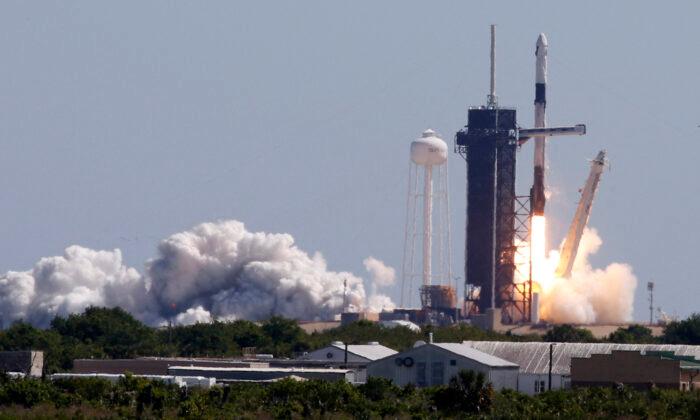The first all-private team of astronauts ever launched to the International Space Station (ISS) were welcomed aboard the orbiting research platform on Saturday to begin a weeklong science mission hailed as a milestone in commercial spaceflight.
Their arrival came about 21 hours after the four-man team representing Houston-based startup company Axiom Space Inc lifted off on Friday from NASA’s Kennedy Space Center, riding atop a SpaceX-launched Falcon 9 rocket.
The Crew Dragon capsule lofted into orbit by the rocket docked with the ISS at about 8:30 a.m. ET (1230 GMT) on Saturday as the two space vehicles were flying roughly 250 miles above the central Atlantic Ocean, a live webcast of the coupling from the National Aeronautics and Space Administration showed.
The final approach was delayed for about 45 minutes by a technical glitch with a video feed used to monitor the capsule’s rendezvous with the ISS, but it otherwise proceeded smoothly.
The multinational Axiom team, planning to spend eight days in orbit, was led by retired Spanish-born NASA astronaut Michael Lopez-Alegria, 63, the company’s vice president for business development.
His second-in-command was Larry Connor, a real estate and technology entrepreneur and aerobatics aviator from Ohio designated as the mission pilot. Connor is in his 70s, but the company did not provide his precise age.
Rounding out the Ax-1 crew were investor-philanthropist and former Israeli fighter pilot Eytan Stibbe, 64, and Canadian businessman and philanthropist Mark Pathy, 52, both serving as mission specialists.
With docking achieved, it took nearly two hours for the sealed passageway between the space station and crew capsule to be pressurized and checked for leaks before hatches were opened to allow the newly arrived astronauts to come aboard the ISS.
The Ax-1 team was welcomed by all seven of the regular, government-paid crew members already occupying the space station: three American astronauts, a German astronaut from the European Space Agency and three Russian cosmonauts.
The NASA webcast showed the four smiling Axiom astronauts, dressed in navy blue flight suits, floating headfirst, one by one, through the portal into the space station, warmly greeted with hugs and handshakes by the ISS crew.
Lopez-Alegria later pinned astronaut wings onto the uniforms of the three spaceflight rookies of his Axiom team—Connor, Stibbe, and Pathy—during a brief welcome ceremony.
Science Focused
The new arrivals brought with them two dozen science and biomedical experiments to conduct aboard ISS, including research on brain health, cardiac stem cells, cancer and aging, as well as a technology demonstration to produce optics using the surface tension of fluids in microgravity.The mission, a collaboration among Axiom, Elon Musk’s rocket company SpaceX and NASA, has been touted by all three as a major step in the expansion of space-based commercial activities collectively referred to by insiders as the low-Earth orbit economy, or “LEO economy” for short.
NASA officials say the trend will help the U.S. space agency focus more of its resources on big-science exploration, including its Artemis program to send humans back to the moon and ultimately to Mars.
While the space station has hosted civilian visitors from time to time, the Ax-1 mission marks the first all-commercial team of astronauts sent to ISS for its intended purpose as an orbiting research laboratory.
The Axiom mission also stands as SpaceX’s sixth human spaceflight in nearly two years, following four NASA astronaut missions to the space station and the Inspiration 4 launch in September that sent an all-civilian crew into orbit for the first time. That flight did not dock with the ISS.
Axiom executives say their astronaut ventures and plans to build a private space station in Earth orbit go far beyond the astro-tourism services offered to wealthy thrill-seekers by such companies as Blue Origin and Virgin Galactic, owned respectively by billionaire entrepreneurs Jeff Bezos and Richard Branson.





